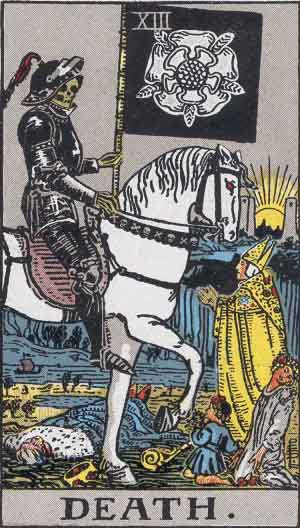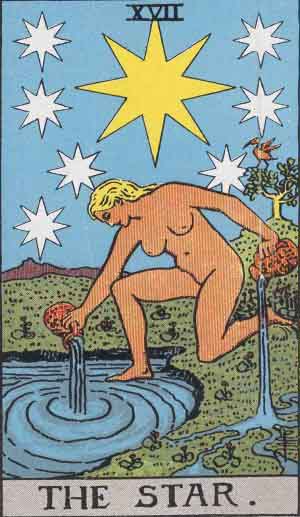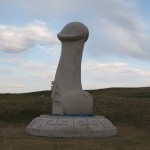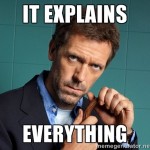This is Part 2 of a 2-part series where I nominate people from among Pagan celebrities living and dead who represent for me the 22 trump cards of the Tarot. You can read Part 1 here.
11. Justice (fairness, balance, proportion)
2-way Tie: Selena Fox (1949-present): advocate for Pagan rights; and Starhawk (1951-present): feminist and environmental activist. I know I’ve used both of these ladies for other cards in Part 1 (Selena was Strength and Starhawk was Empress), but I don’t think anyone will begrudge me overemphasizing either of these amazing women. Selena is nominated for the Justice card because of her work with the Lady Liberty League which works to fight discrimination against Pagans. Among other legal victories, the League won approval to place pentacles on the memorial markers for Wiccan soldiers killed in the line of duty.
Starhawk is nominated for her work. No, I didn’t leave the end of that sentence off. Starhawk’s name is synonymous with action. She has consistently pushed for a vision of Paganism as practical and spirituality as political. She has led protests seeking peace and justice for the environment and for women and sees these as an expression of her spirituality. In addition to her more well known book, The Spiral Dance, Starhawk is the author of Dreaming the Dark (1982) and Truth or Dare (1988), both of which bridge Paganism and political action. Pagans can be sometimes be prone to narcissism, so Starhawk’s practicality is a needed corrective.
Runner-up: Patrick McCollum (1950-present): Wiccan chaplain and advocate for rights of Pagan inmates.
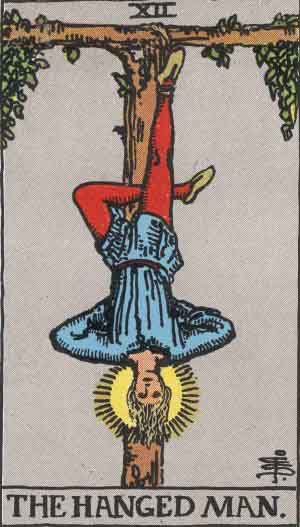 12. Hanged Man (sacrifice, ordeal, Prometheus)
12. Hanged Man (sacrifice, ordeal, Prometheus)
James Frazer (1854-1941): social anthropologist. In 1890, Frazer published the first edition of his masterpiece, The Golden Bough. The second edition (3 vols.) was published in 1900. The third 12-volume edition was published between 1906 and 1915. Finally, a single-volume abridged edition was published in 1922, making it more accessible to the general public. The Golden Bough posits that ancient peoples believed in a dying and reviving god representing the animating spirit of vegetation, and represented in human form as sacral kings who are (sometimes voluntarily) sacrificed after a term or when their power of mind or body failed, in order to ensure the cyclical renewal of life. The extent of the influence of James Frazer on Neo paganismspecifically can hardly be overstated. This is highly ironic, because Frazer himself was a modernist who saw all religion as superstition which should be overcome through reason. Inspired by Frazer, members of the Cambridge “Myth and Ritual School” “reconstructed a set of rites synchronized to the seasonal cycle of planting and harvesting in which the king was killed, descended to the underworld, fought against the force of darkness, then resurrected to celebrate a divine marriage with the temple priestess / sacred concubine” (Magliocco). Robert Graves drew on on Frazer’s Dying God archetype when he created his myth about the cyclical relationship between the Goddess and her consort, which became the mythos behind the Neopagan Wheel of the Year; but Graves split Frazer’s dying and resurrecting god into the gods of the waxing and waning year. I chose Frazer for the Hanged Man card because the imagery of the card can be interpreted as a voluntary sacrifice such as the type described by Frazer.
Honorable Mention: Robert Cochrane (1931-1966): witch. Robert Cochrane was the founder of the Clan of Tubal Cain, a contender with Gardnerian and Alexandrian Wicca for the elusive title of a genuine witchcraft survival. Cochrane died after ingesting belladonna on Midsummer’s Eve in 1966. In some interpretations of the Wheel of the Year, Midsummer’s Eve is when the consort of the Goddess is sacrificed. Other witchcraft traditions were influenced by Cochrane, including Joseph Wilson’s 1734 Tradition and the Roebuck Tradition. Doreen Valiente was also a member of Cochrane’s coven for two years until shortly before Cochrane’s death. Cochrane’s wife burned many of his papers after his dead, so he remains a mysterious figure in Neopagan history. I chose him for the Hanged Man card not only because of the circumstances of his death, but because of his ambiguous character as both fraud and genuine mystic.
Gwydion Pendderwen (1946-1982): musician, witch. Gwydion died in a car accident in 1982. He was Paganism’s first bard. Gwydion recorded “We Won’t Wait Any Longer” and a Pagan version of “Lord of the Dance”. He released his first album, Songs for the Old Religion, in 1975. Gwydion was initiated by Victor Anderson into the Feri tradition. He founded Nemeton, which was intended to serve as the West Coast sister organization to the Pagan Way. Nemeton became a part of the Church of All Worlds.
Gwydion’s untimely death was the one of the Neopagan community’s first confrontations with death. Below are two of Gwydion’s poems about death and life, the second one written from a first-person posthumous perspective:
I doubt all, save the survival
Of some unquenchable fire within me;
I seek no immortality,
For it comes without search.
I live with the joy of my senses,
Knowing that this part will surely perish,
Leaving only that which came before.
To live here and now, without that certainty,
Without the acceptance of Death as the unveiling of the One,
Is to forget,
Forever,
The secret name that is whispered at birth
Beyond the hidden gates.— “Metempsychosis” by Gwydion Pendderwen
The poem below was read at his memorial:
Do not stand at my grave and weep.
I am not there.
I do not sleep.
I am a thousand winds that blow.
I am the diamond glints on snow.
I am the sunlight on ripened grain.
I am the gentle autumn rain.
When you awaken in the morning’s hush,
I am the swift uplifting rush
of quiet birds in circling flight.
I am the soft star that shines at night.
Do not stand at my grave and cry.
I am not there. I did not die.— “Goodbye” by Mary Elizabeth Frye
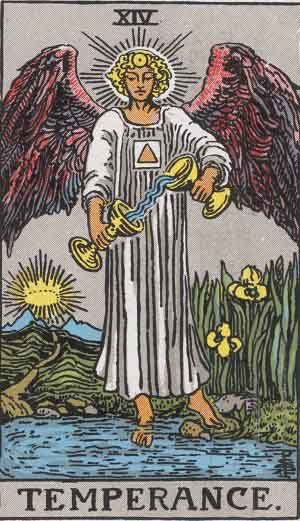 14. Temperance (equilibrium, self-mastery, restraint of appetite)
14. Temperance (equilibrium, self-mastery, restraint of appetite)
Teo Bishop (1979-present): bard, musician, blogger. Teo is also the popular musician Matt Morris. None of my other nominations thus far have been from among my contemporaries and none have been bloggers. But in the Internet age, when so many people are discovering Paganism on the Internet, it seems only right to include such an exceptional internet personality as Teo here. Anyone who has spent anytime online knows how anonymity drives down the level of discourse. Teo has consistently raised the level of discourse in the Pagan community. No matter what controversy is brewing in the blogosphere, Teo has always brought a measure of compassion, spiritual equilibrium, and genuine insight to the discussion. Anyone who follows his blog knows what I am talking about.
Runner-up: Christine Hoff Kraemer, editor of the Patheos Pagan channel. Anyone who so marvelously maintains order in this Pagan internet community, while simultaneously allowing the free exchange of ideas and feelings, deserves the nomination for the card depicting an angelic figure strategically placed between Death and the Devil.
Honorable Mention: Thalassa for her Etiquette Guidelines for Interfaith Discussions, which apply equally well to intra-faith discussions.
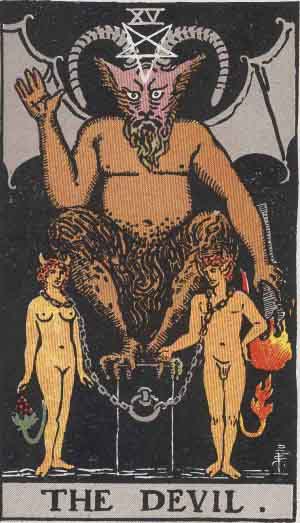 15. Devil (matter, sexual desire, Pan)
15. Devil (matter, sexual desire, Pan)
Margaret Murray (1863-1963): anthropologist, author. Murray is nominated for the Devil card because of the influence of her book, The God of the Witches (1933), on the contemporary Pagan conception of the Horned God. While Neopagans do not worship the Christian Satan, the Horned God is arguably both historically and conceptually related to, if not derivative of, Satan. Ronald Hutton has convincingly demonstrated that the Neopagan Horned God has its origin in a modern re-paganization of medieval Christian devil imagery employed Jules Michelet and Margaret Murray. In addition, the Horned God may be understood as a valorization of our animal or sexual nature, which has been demonized in the form of the Christian Satan.
Runner up: Aleister Crowley, “The Great Beast”, “The Most Wicked Man in the World”, and the nominee for the Fool card in Part 1.
Second tunner-up: Anton LaVey (1930-1997), founder of the Church of Satan and author of The Satanic Bible. Most contemporary Pagans would distance themselves from Satanism of any form. LaVey’s philosophical Satanism was a mixture of Nietzsche, Ayn Rand, and a flair for the dramatic. While his ethics differed from those of most Pagans today, LaVey’s metaphorical reclaiming of Christian symbols and his penchant for cathartic ritual has a lot in common with Neopaganism.
Honorable Mention: Jason Mankey: witch, blogger, devotee of the Horned God, and rock and roll and drinking enthusiast. Just ’cause it seemed like a shame to bring up the Horned God without mentioning Jason, and ’cause Jason is awesome.
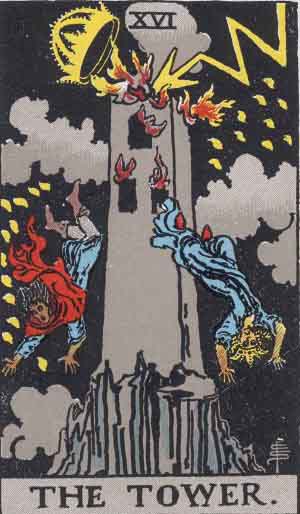 16. Tower (ruin, hubris, wrath)
16. Tower (ruin, hubris, wrath)
“Lightning is the source of your pain and liberation.” — T. Thorn Coyle
T. Thorn Coyle (1965-present): author, teacher. Thorn was trained in the Feri and Reclaiming traditions, and she now leads her own mystery school. She is athe author of Evolutionary Witchcraft and Kissing the Limitless. I associate Thorn, not with the Tower, but with the lightning striking the tower. Neopaganism tends to be eclectic and eschew tradition. As a result, it can sometimes be spiritually shallow. Thorn is a bolt of divine lightning sent from the gods to destroy our pretensions to spiritual sophistication. And for slackers like myself, her message is as serious as a bolt of lightning. I participated in a ritual led by Thorn at Pantheacon and it indeed felt like being in the middle of a thunderstorm.
Victor and Cora Anderson (1917-2001/1915-2008): founders of the Feri (Faery) tradition, Huna priest. The Andersons’ Feri tradition was influenced by, but distinguishable from, Wicca. Victor Anderson was also influenced by Hawaiian Huna, and the Feri tradition emphasizes ecstatic experience. In 1971, Victor Anderson and Gwydion Pendderwen created a Feri coven with Alison Harlow. (Harlow went on to become the first President of the Covenant of the Goddess.) Anderson also initiated Starhawk, who published her feminist version of Feri witchcraft in The Spiral Dance. In addition, in 1974, Feri and Aidan Kelly’s NGROOD came into contact and cross-fertilized. I associate the Andersons with the Star card because the “Star Goddess” is the central deity of the Feri tradition, called “God Herself” and the Womb of the Universe.
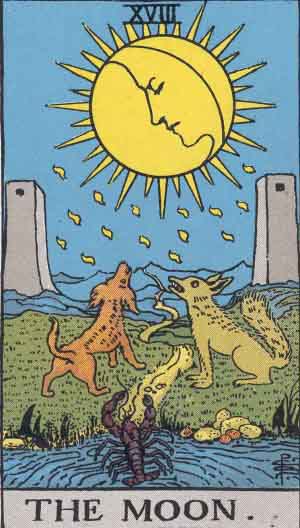 18. Moon (duality, fluctuation, illusion, the primal, the animal)
18. Moon (duality, fluctuation, illusion, the primal, the animal)
3-Way Tie: Dion Fortune (1890-1946): occultist, mystic, psychologist; and Jane Ellen Harrison (1850-1928): classicist and proto-feminist; and Janet Farrar (1950-present), witch and author.
Dion Fortune was a well-known occultist of the early 20th century. Her biographer, Alan Richardson, has called her “Womanhood’s answer to Aleister Crowley” and “the Shakti of the Age”. She belonged to the Hermetic Order of the Golden Dawn and founded her own occult order, the Society of Inner Light. The influence of Fortune on Paganism has been well documented by Ronald Hutton in his Triumph of the Moon. Hutton describes her greatest single legacy to modern Pagan witchcraft to be her idea of magical polarity, the notion that erotic attraction between the sexes could be channeled into magical operations. Fortune worked this notion into her fiction, like The Sea Priestess (1938) and The Goat Foot God (1936), which later inspired the Neopagan Goddess and Horned God. Fortune coined the phrase, “A religion without a goddess is halfway to atheism”, and Fortune’s writings inspired Doreen Valiente to introduced a larger role for the Goddess (and hence the High Priestess) into Gardnerian witchcraft. Without Fortune’s (and Valiente’s) influence, it is likely that the women’s spirituality movement of the 1970s would never have embraced Neopagan witchcraft, and witchcraft would have remained an obscure esoteric tradition.
Fortune studied psychology and actually practiced as a psychoanalyst for a time. In the course of her studies, she was influenced most strongly by the writings of Freud and Jung. She is credited by Chas Clifton with being the first occult author to approach magic from a Jungian perspective. Fortune’s most famous quotation for Pagans is “All the gods are one god, and all the goddesses are one goddess, and there is one initiator”.
In her Sea Priestess the Goddess is frequently manifest in the Moon. And the sequel is called Moon Magic (1956, published posthumously). I associate Fortune with the Moon card because of the importance of her writings to the Neopagan conception of the Moon Goddess, and also because of the variable nature of her attitude toward paganism (as documented by Ronald Hutton in Triumph of the Moon).
Jane Ellen Harrison was Britain’s first female career academic. Her major works included Prolegomena to the Study of Greek Religion (1903) and Themis: A Study of the Social Origins of Greek Religion (1927). Harrison was a student of James Frazer and the most influential member of the Cambridge “Myth and Ritual” school. She was a major influence on Arthur Evans, who discovered the ancient civilization on Crete, Ernest Westlake, founder of the Order of Woodcraft Chivalry, Robert Graves, author of The White Goddess, and Zsuzsanna Budapest, founder of the Dianic witchcraft tradition.
While it is fairly said that Robert Graves’ god derives from James Frazer’s dying god, it is equally true that Graves’ goddess derives from Harrison’s goddess. Frazer himself did discuss goddesses, but in his pursuit of the dying god, he failed to fully realize that at the heart of the fertility cults stood the Mother Goddess. As Martha Carpentier explains in Ritual, Myth, and the Modernist Text (1998): “Frazer’s primary interest was in the male archetype of Dying God, which could be said to be the unifying theme of the entire Golden Bough. But this male archetype is invariable in the service of a more powerful goddess; he is ritually slain in order to engender her fertility.”
One theme of Harrison’s writing to have a profound impact on Neopaganism is the conception of a chthonic matriarchal (Greek) religion which predated the Olympian patriarchal cult. According to Harrison, the goddesses in matriarchal religion were husband-less. They were accompanied by a son (sometime lover), but this male figure was always subordinate to the goddess. He was defined by his relation to the Goddess, not vice versa. It is this relationship which is taken up later by Robert Graves and then adopted by Neopaganism. With the coming of Olympian theology, the relationship was reversed, and the goddesses were “sequestered to servile domesticity” and became abject and amorous”. As Harrison describes it,
“Zeus the Father will have no great Earth-goddess, Mother and Maid in one, in his man-fashioned Olympus, but her figure is from the beginning, so he re-makes it; woman, who was the inspirer, becomes the temptress; she who made all things, gods and mortals alike, is become their plaything, their slave, dowered only with physical beauty.”
It’s no wonder that Harrison appealed to feminists like Zsuzsanna Budapest.
Harrison was exclusively interested in the Maiden and Mother archetypes and never explored the Crone aspect at all. (That was Robert Graves’ contribution.) But she is responsible for describing the goddesses Demeter and Kore as the Mother and Maiden aspects of a single goddess. “The Mother and the Maid are two persons, but one god,” she wrote, “the young and old form of a divinity always waxing and waning.” In Themis, Harrison associates both the three Horae (Seasons) and the three Moirae (Fates) with the three phases of the moon. While it was left to Robert Graves to develop Harrison’s dual-aspect goddess into the Neopagan Triple Goddess, it is fair to say that that Harrison gave to Graves all of the elements he needed to articulate the motif: the notion of a single goddess with multiple aspects (unity within multiplicity), the association of the aspects of goddess with different phases of a woman’s life, and the association with the moon’s phases. Like Fortune, I associate Harrison with the Moon card because of the importance of her writings to the Neopagan conception of the Moon Goddess.
Janet Farrar and her husband Stewart were initiates of Alex Sanders. In 1971, Janet and Stewart left Sanders’ coven to found their own. They met Doreen Valiente and became two of the most influential Wiccan authors, starting with The Witches Way (1984) which fleshes out some of the philosophy of Wicca. The Farrars went on to publish The Witches’ Goddess (1987) and The Witches’ God (1989), which describe various feminine and masculine archetypal principles such as the “Earth Mother”, the “Bright and Dark Mother”, and the “Triple Goddess”, and the “Son/Lover”, the “Vegetation God”, and the “Horned God”. Janet’s husband, Stewart, died in 2000, and she married Gavin Bone in 2001. Together they published Progressive Witchcraft in 2004. The book was a significant departure from Janet’s earlier work. Previously, the Farrars’ books showed a strong influence of Jung’s archetypal psychology. However, in Progressive Witchcraft, Janet and Gavin adopted a new approach to polytheism which they called “deity-centered” witchcraft. The book marked a significant shift in the wider Pagan community toward hard polytheism. I associate Janet with the Moon card because of the importance of her writings to the Neopagan conception of the Moon Goddess, and also because of how the change in her view of deity has reflected changes within the larger Pagan community.
19. Sun (innocence, joy, child, Apollo)
YOU. That’s right! The golden boy/girl/other of Paganism is you. And me. And everyone else. We are the future of Paganism. Well, not me really. And not you if you’re over 35. But to anyone who is reading this who is under 35: YOU.
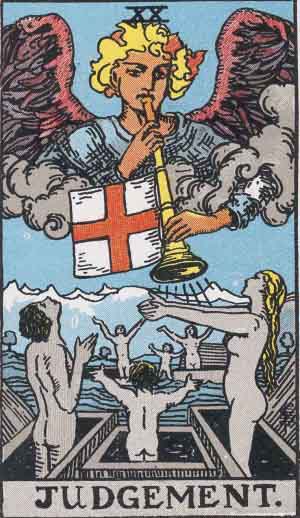 20. Judgment (resurrection, renewal)
20. Judgment (resurrection, renewal)
Ronald Hutton (1950-present): historian, Wiccan. Hutton is the author of the seminal work on the history of British Neopagan Witchcraft, The Triumph of the Moon, in which he locates the origins of Neopagan witchcraft, not in matriarchal prehistory or medieval witchcraft, but in the Romantic movement. Hutton has been called a “gentle iconoclast”. He is viewed by many as debunking Wiccca’s origin myths: witchcraft as a pagan survival, the Burning Times, and matriarchal prehistory. But Hutton prefers to emphasize what he gave to contemporary Paganism, rather than what he took away. In the place of a historically untrue myths (which had already been debunked by others), Hutton gave us the historically true myth of Wicca as “the only religion that England has ever given the world.” Triumph of the Moon was one of the first Pagan books I ever read, and I was inspired by his vision of Neopaganism as a Neo-Romantic revival to become Pagan myself.
Runner-up: Aidan Kelly (1940-present) for his book, Crafting the Art of Magic (1991) which analyzed the text of Gardner’s Book of Shadows, casting serious doubt on the legitimacy of Gardner’s claims to have been initiated into a survival of an ancient witchcraft religion. Kelly’s book represented one of the first academic studies into the origins of Wicca. Kelly could also be associated with the Judgment card, which symbolized rebirth, due to the cyclical nature of his religious affiliation: Kelly co-founded the New Reformed Order of the Golden Dawn in 1967, which Sarah Pike marks as the beginning of Neopaganism, together with the founding of Feraferia the same year. In 1977, Kelly returned to the Catholicism of his youth and reported his belief that the Neopagan Goddess was derivative from the Christian Mary. Later, in 1987, he returned to Paganism.
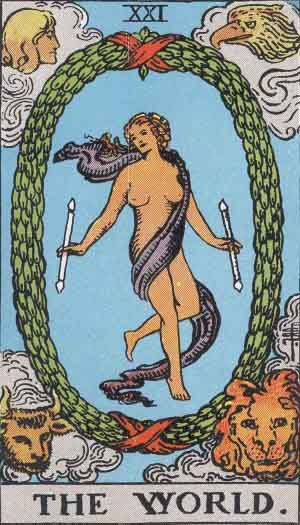 21. World (completeness, wholeness, totality)
21. World (completeness, wholeness, totality)
Jason Pitzl-Waters: religion-beat journalist, blogger, and Pagan music enthusiast. Jason blogs at The Wild Hunt. The Wild Hunt is the primary destination for anyone interested in following news relating to or of interest to modern Pagans. Founded in 2004, The Wild Hunt has become one of the most-visited and popular Pagan internet sites. Jason is the nominee for the World card because he has, almost single-handedly, connected contemporary Paganism with the rest of the world. Pagans can be very insular by nature. Jason’s journalism consistently and competently puts our parochial interests in the context of other minority faiths and broader world events.
Runners-up: Wren Walker and Fritz Jung, founders of The Witches’ Voice internet community. I want to thank Peg Aloi for educating me about the significance of The Witches’ Voice. As Peg explains in the comments below, “Wren and Fritz were the standard bearers for developing pagan networking on a worldwide basis via the internet (Fritz’s design work in this regard was absolutely visionary), and were also the first pagan website to devote pages to consistent pagan-oriented news coverage.”


